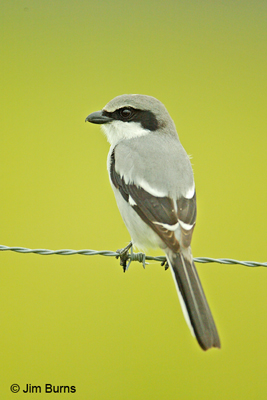
As we glassed the bird, the begging calls continued from the desiccated vegetation lining the fence in both directions as far as we could see. The young bird was apparently still somewhere on the ground across from us, but our eyes and ears went to something else down the road and we moved on to investigate a smaller bird that had flipped into a bush at our approach.
Half an hour later, retracing our steps, we heard the same begging calls coming from the same place. Now two Loggerhead Shrikes left the gravel and flew to the wires, settling there some twenty feet apart. Assuming we were now looking at both parents and a young of the year bird was still on the ground, we again dropped the binoculars and began to walk away. Suddenly one of the birds on the wire flew toward the other and attacked it, both birds now uttering the calls we had mistaken for begging.
The birds tumbled from the wire and landed together on the ground amidst thrashing claws and flailing wings, one or both making the same odd sounds. Camera in hand, I shot a few frames before I realized I had no idea what settings I was using. The altercation continued for several seconds, then broke off just as I raised the camera to shoot again with a properly adjusted shutter speed. The combatants left in the same direction, one going into a tree a hundred yards away, the other veering off into thick brush. We looked at one another, puzzled.
There seemed to be three possibilities: the aggressor was a parent, the victim a young of the year bird being driven out of the natal territory, but neither bird had shown any juvenile plumage; the aggressor was the territorial resident, the victim an interloping neighbor, but with nesting season long over why would the former be so aggressive; the aggressor was the territorial resident, the victim an early migrant from farther north, but second week of August would probably be an earliest date record for shrike migration in central Texas.
We hung around the general area for another hour or so and were never out of earshot of the “begging” calls of the two shrikes. In our understanding, really our lack thereof, we began referring to the sounds as “scolding.” We continued to see chasing and presumed there was more agonistic behavior taking place, though it did not again occur close enough for us to observe it. The few frames the camera had recorded were unrecognizable blurs of gray and black which were of no help in solving the mysterious interaction.
This, ultimately, is one of the allures of birding. One of the things which draws us into the field with bins and lens. Birds continue to amaze us, and there is so much about them we do not know or understand, so much that is imponderable. I will never see a shrike again without thinking about this mysterious, unresolved incident.
* * * *
Check our Loggerhead Shrike page to see why it's often called the Butcher Bird.